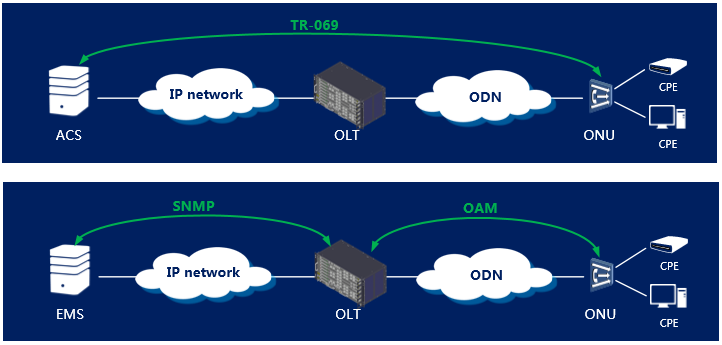TR-069 defines a brand new network management system (NMS) structure, including management models, interworking interfaces, and management parameters, which greatly reduces O&M costs for network products. It defines a mechanism between the customer premises equipment (CPE) and the auto-configuration server (ACS). This mechanism contains secure and automatic CPE configuration, integrates other CPE management functions, and provides the general framework, message specification, management method, and data model to manage and configure terminals that need to be remotely managed on the next-generation network.

As VoIP devices, IPTV, and other IP terminals become more popular (especially in households), configuration and maintenance of a large number of devices becomes increasingly challenging, which greatly adds the costs for network product operators. Traditional SNMP-based NMSs are insufficient in managing massive terminals and become the bottleneck in growing the broadband access market. TR-069 defines a brand new NMS structure, including management models, interworking interfaces, and management parameters, which greatly reduces O&M costs for network products.
TR-069 defines a mechanism between the CPE and the ACS, which contains secure and automatic CPE configuration, integrates other CPE management functions, and provides the general framework, message specification, management method, and data model to manage and configure terminals that need to be remotely managed on the next-generation network.
The TR-069 protocol currently supports the following functions:
1. Automatic CPE configuration and dynamic service configuration
For ACSs, each CPE can mark itself (using its model or version) in the protocol. Based on configurable rules, an ACS can issue configuration to a specific CPE or a group of CPEs. After startup, a CPE can automatically request configuration information on the ACS, and the ACS can initiate configuration at any time. This function ensures CPE installation without configuration and controls dynamic changes of service parameters on the network side.
2. CPE software and hardware management
TR-069 provides the function of managing and downloading CPE software and hardware. An ACS identifies the CPE version, determines whether to remotely update the software version of the CPE, and checks whether the update is successful. For example, if new software must be loaded on a CPE to achieve new service functions or bugs must be fixed for the existing software, this function ensures remote CPE management and upgrade.
3. CPE status and performance monitoring
TR-069 defines measures for ACSs to monitor CPE status and performance, which contain general performance parameters to reflect the working status of the current CPE. TR-069 also provides standard syntax for operators to define additional parameters.
4. Communication fault diagnosis TR-069 defines capabilities for CPE self-diagnosis and reporting. For example, under directions of an ACS, a CPE checks the connectivity and bandwidth between itself and the network service supply point by running the ping command or other means, and returns the result to the ACS. In this case, operators can simply locate CPE faults reported by users through remote operations and perform troubleshooting accordingly.
Calibration is a mandatory step in production check for the WiFi module of each ONU. It mainly involves calibration of frequency offset and power. Chips, oscillators, and RF links are different by nature, so a dedicated instrument must be used for data calibration to ensure optimal ONU performance. The factory delivery calibration process is strictly implemented for the WiFi module of PN8625 and PN8626 series ONUs, and the WiFi module calibration data of ONUs in all production lines is recorded in the production system for quality tracing and control.








